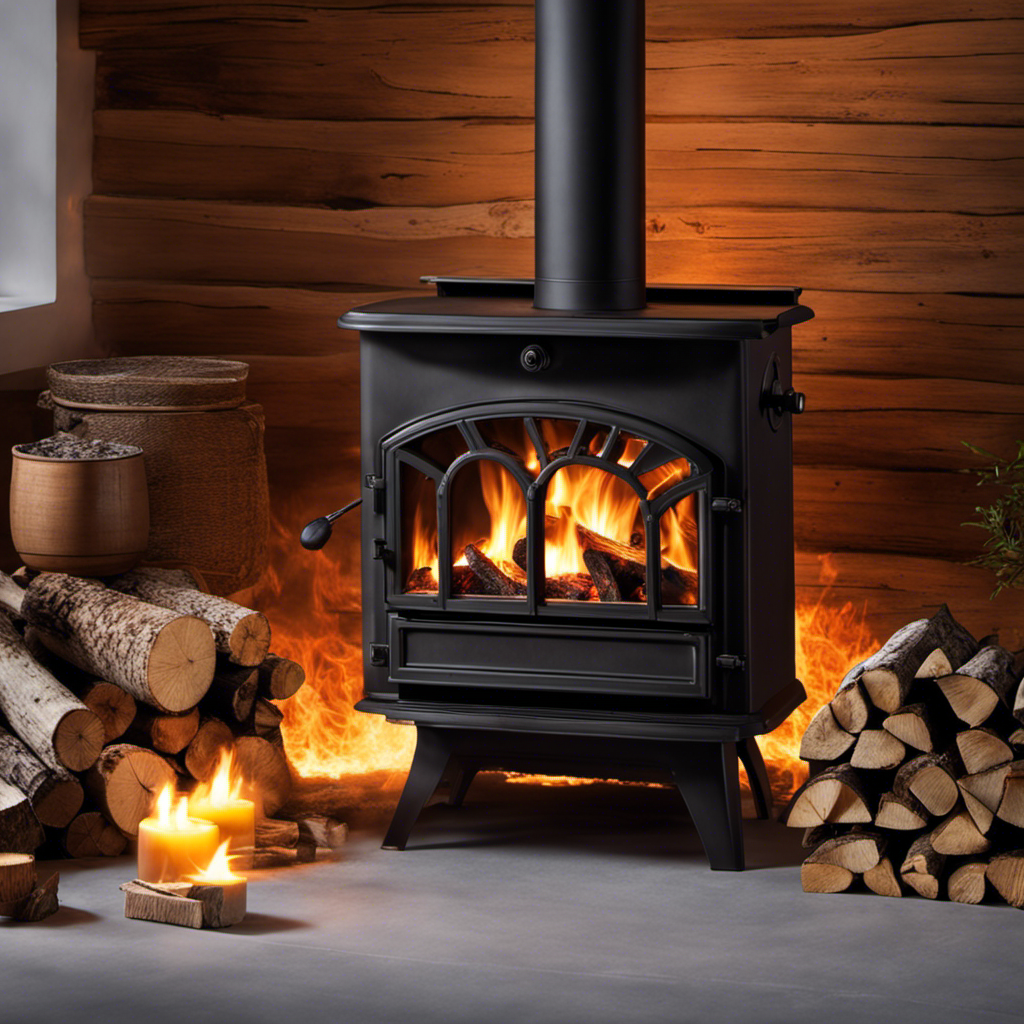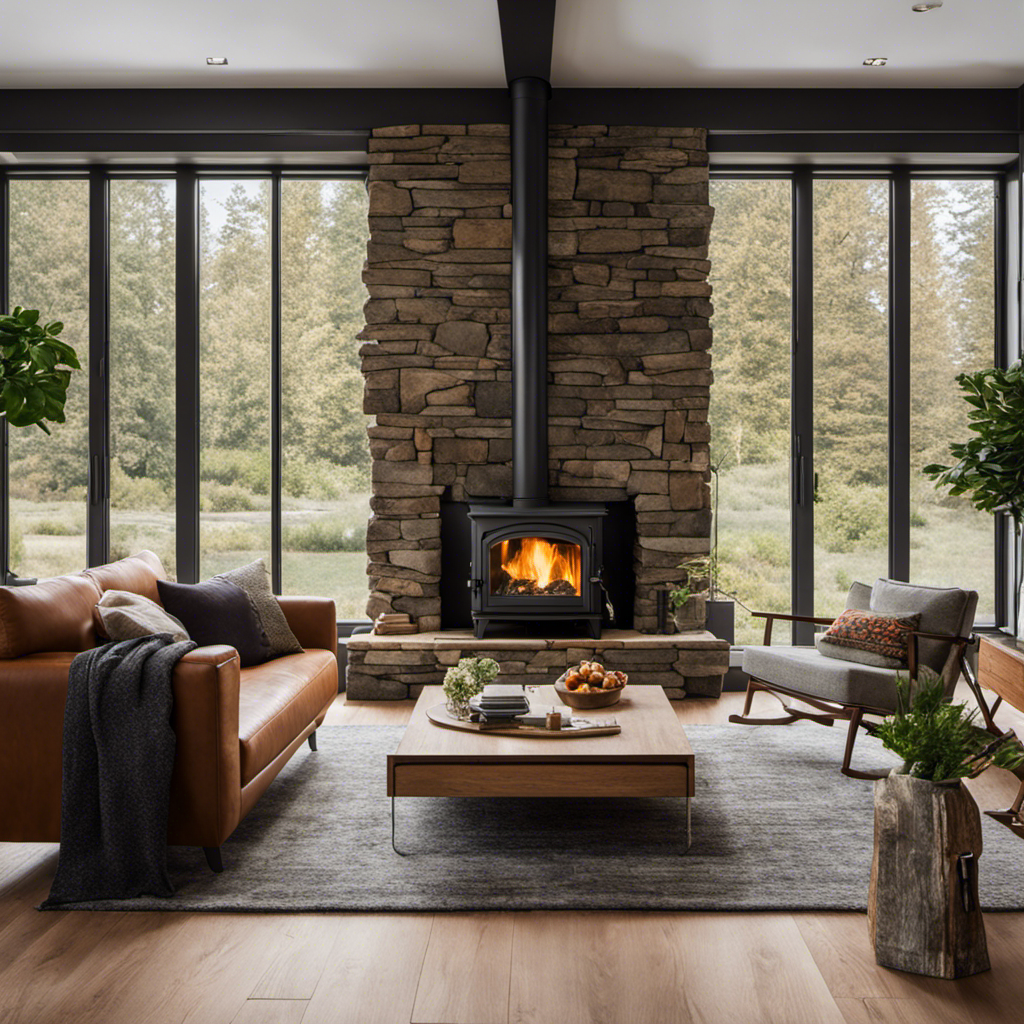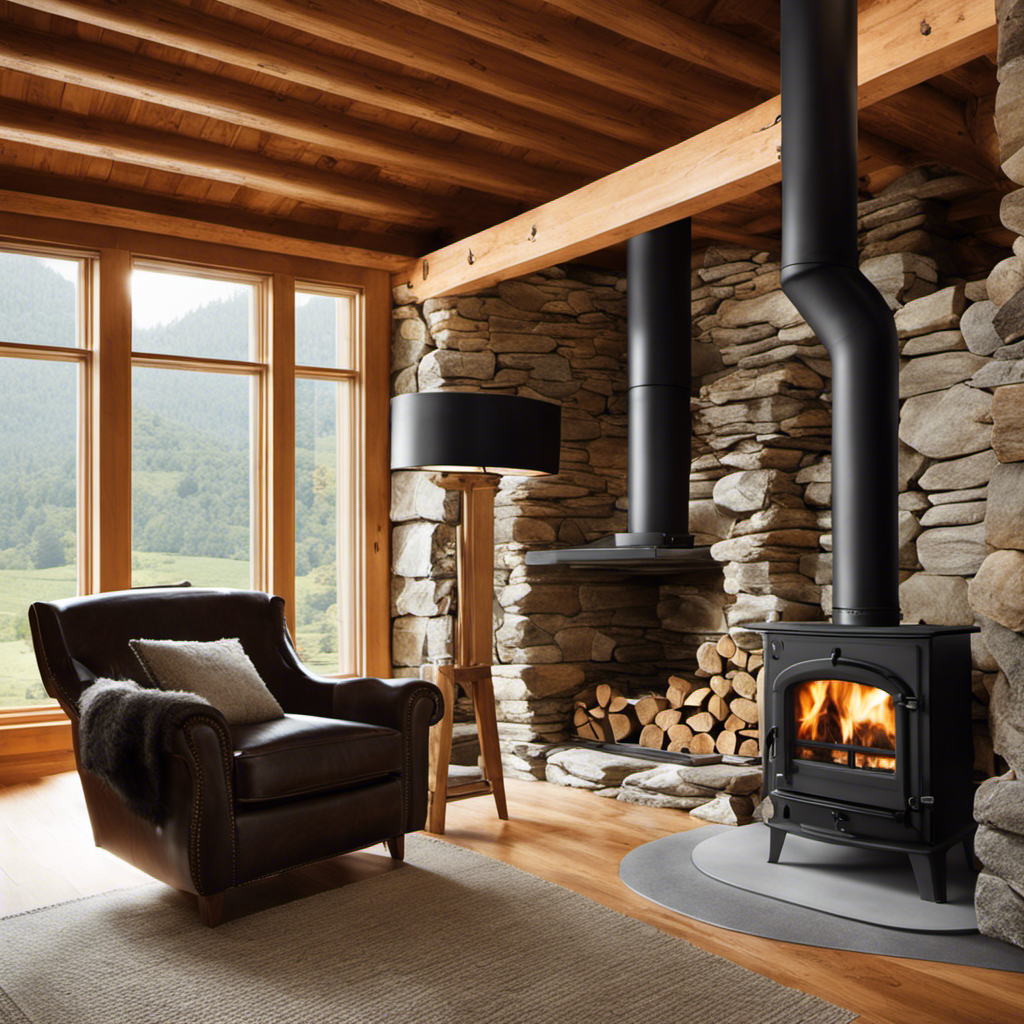I often ponder as a passionate wood stove enthusiast: what is the ideal burn time for firewood in a wood stove?
It’s a question that’s sparked my curiosity and led me on a quest for answers.
In this article, we’ll explore the factors that affect firewood burning time, from the type of wood and its moisture content to the design of the wood stove itself.
Get ready to maximize your firewood burning efficiency and enjoy cozy nights by the fire.
Key Takeaways
- The type of wood, specifically hardwoods like oak and maple, burn longer in a wood stove compared to softwoods like pine and cedar.
- Properly seasoned firewood with low moisture content, around 20%, ensures efficient burning and longer burn times.
- Wood stove design, including insulation and airflow control features, can impact burning time and maximize heat output.
- Maximizing firewood burning efficiency can be achieved by splitting and stacking firewood for better airflow, storing it in a dry and well-ventilated area, considering alternative fuel sources, and regularly cleaning and maintaining the wood stove.
Factors Affecting Firewood Burning Time
I’ve noticed that the type of wood and moisture content greatly affect how long firewood burns for in my wood stove. The type of wood determines its density and heat output. Hardwoods like oak and maple burn longer and produce more heat compared to softwoods like pine and spruce.
Moisture content is equally important. Wet or green firewood contains a lot of water, which reduces its heat output and makes it difficult to burn efficiently. Properly seasoned firewood, on the other hand, has a moisture content of around 20%, allowing for optimal heat production and a longer burn time.
It’s crucial to store firewood in a way that promotes drying, such as stacking it in a well-ventilated area with good air circulation. This ensures that the firewood is dry and ready to provide a consistent and efficient heat source in the wood stove.
The Type of Wood and Its Burning Duration
I find that the type of wood used greatly affects how long it burns in my wood stove. Different wood species have varying burn times, which is important to consider when choosing firewood for optimal burning duration. Hardwoods like oak, maple, and hickory tend to burn longer and produce more heat compared to softwoods like pine and cedar.
The density and moisture content of the wood also play a role in how long it burns. Seasoning firewood by allowing it to dry for at least six months can help reduce its moisture content, making it burn more efficiently and for a longer period of time.
The type of wood and its burn time are crucial factors to consider when planning for a cozy and efficient fire in your wood stove.
Speaking of moisture content, it’s important to highlight the significance of firewood moisture content in relation to burning duration.
Importance of Firewood Moisture Content
Using properly seasoned firewood with a low moisture content ensures efficient burning, and therefore, allows for a longer and more enjoyable fire in the wood stove. Firewood storage techniques are crucial in maintaining the moisture content of the wood.
It’s important to stack the firewood in a way that allows for proper airflow, such as in a criss-cross pattern. This promotes drying and prevents the growth of mold and fungi. Additionally, it’s essential to keep the firewood off the ground to prevent moisture absorption.
Drying firewood properly involves splitting the wood into smaller pieces to increase surface area and accelerate the drying process. The firewood should be stored in a dry and covered area, protecting it from rain or snow.
How Wood Stove Design Impacts Burning Time
The efficiency of a wood stove’s design greatly affects the burning time of firewood. One key factor in this efficiency is wood stove insulation. Proper insulation helps to retain heat within the stove, preventing it from escaping and wasting energy. This allows the firewood to burn more slowly and for a longer period of time.
Another important aspect is airflow control. A well-designed wood stove should have mechanisms to regulate the amount of air entering the combustion chamber. This controls the rate at which the fire burns, determining how quickly the firewood is consumed. By adjusting the airflow, you can extend the burning time of the firewood and maximize the heat output of the stove.
Therefore, when choosing a wood stove, consider its insulation and airflow control features to ensure optimal burning time for your firewood.
Tips for Maximizing Firewood Burning Efficiency
To maximize firewood burning efficiency, it’s important to properly stack and store a sufficient amount of dry firewood. By following the right firewood stacking techniques, you can ensure that your wood stove burns efficiently and produces maximum heat.
Here are some tips to help you maximize firewood burning efficiency:
-
Split and stack firewood: Splitting firewood allows for better airflow and faster drying. Stack the split firewood in a neat and organized manner to promote airflow and prevent moisture buildup.
-
Store firewood in a dry location: Moisture is the enemy of efficient burning. Make sure to store your firewood in a dry and well-ventilated area, such as a woodshed or covered storage rack.
-
Use alternative fuel sources: While firewood is a traditional and reliable fuel source, it’s worth considering alternative options. Pellets, wood bricks, and coal are all viable alternatives that can provide longer burning times and higher heat output.
-
Properly maintain your wood stove: Regularly clean and inspect your wood stove to ensure it’s operating at its peak efficiency.
Conclusion
So, how long should firewood burn for in a wood stove?
Well, the answer isn’t as straightforward as you might think. It all depends on various factors such as the type of wood, its moisture content, and even the design of your wood stove.
But fear not, my dear readers, for with the right knowledge and a few tips, you can maximize the burning efficiency of your firewood and keep your stove roaring for longer.
Remember, the key to a cozy fire is in the details!
Logan’s affair with adventure began in childhood. He hailed from a small town where vast forests bordered one side and endless shores stretched on the other. His days were spent exploring uncharted woods, climbing tall trees, or listening to the tales of old sailors. This early immersion in a world brimming with stories and mysteries became the foundation of his passion for writing.











